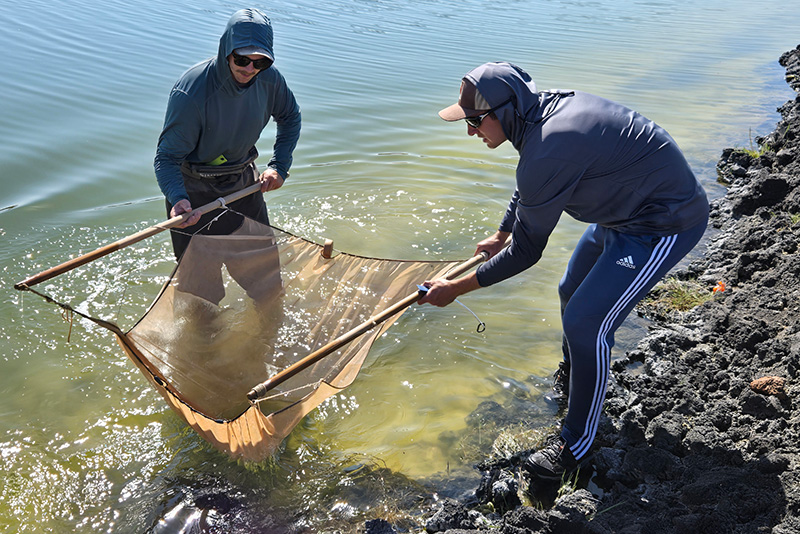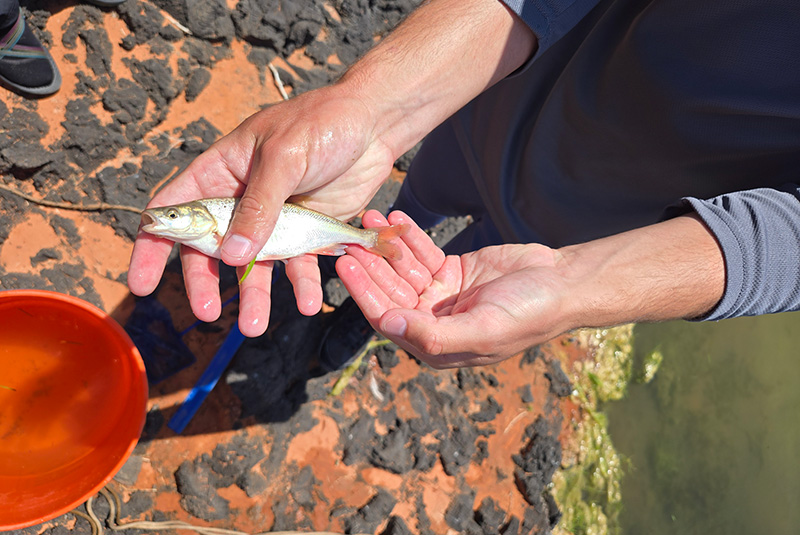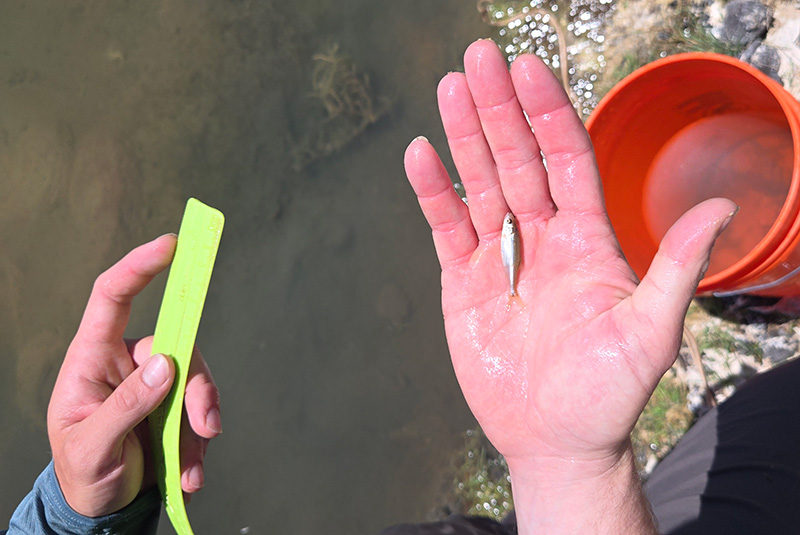
Netting Virgin River Chub fry (newly hatched, juvenile fish) at Black Desert Resort in Ivins, Utah, to check on health and population growth. Photos courtesy of Joseph Platt, Ph.D.
The reintroduction of the endangered Virgin River chub into one of the lakes at Black Desert Resort was something of a gamble.
When 400 of the rare fish fingerlings were installed at the golf course there in March 2024, there was no guarantee they would survive, let alone thrive.
Recent developments would suggest the latter.
“They bred on their own,” reports Joseph Platt, Ph.D., an adjunct professor of biological sciences at Utah Tech University and director of environmental services for Black Desert Resort in Ivins, Utah, where Ken Yates serves as the GCSAA Class A superintendent. “It was a question whether a river fish would breed in calm water, in a lake, but they did, so now we have adult fish, some immature fish, and hundreds of little baby fish. The (Utah) Division of Wildlife Resources people were very excited, because this fish only exists in the Virgin River, which is highly vulnerable to failure, like poisoning or whatever, and in the hatchery. We gave them a separate population that’s in a totally safe lake, with no predators or competitors in it, so they’re very pleased.”
The introduction of the Virgin River chub to the Black Desert Resort lake — a collaboration with the resort, the Utah DWR and the U.S. Fish and Wildlife Service — began in March 2024. Four hundred fingerlings were set free. In April 2025, the DWR delivered another 90 immature fish to encourage genetic diversity.
Not long after, Platt spotted his first Virgin River chub offspring.
“I’d survey that lake every two or three days,” he says. “When it’s hot or cold here, the fish are hard to see. They tend to group at the bottom of the lake, and they’re not moving around much. Prior to that sighting of the baby fish, I had been seeing fish jumping. Well, not really jumping, but they’d break the surface. At the end of May, I saw clouds of little fish, 50-60 little teenagers just hanging out.

An adult Virgin River Chub.
“DWR came out a week or so after I first saw the baby fish and trapped the lake with live traps to get the fish, measure them and get some idea of their breeding activity. It’s kind of neat after Black Desert volunteered to take the risk of bringing this endangered fish in. Nobody knew if it would even survive, let along breed. Now DWR has a separate population of fish they can manipulate.”
The Virgin River chub has been listed as an endangered species since 1989 and is protected under the federal Endangered Species Act.
Platt says the Virgin River is home to six native fish species — three of which exist nowhere else. Two of those, the Virgin River chub and the Woundfin, are federally listed as endangered. He says the chub live along all 160 miles of the Virgin River — that’s the waterway that carved out the canyons of Zion National Park millions of years ago — but it’s not one interconnected population.
“The populations are all separated by dams or obstructions diverting water for agriculture,” he says. “So there are 10 populations of this fish that don’t interact. We have this problem with genetic inferiority. They’re inbreeding.”
That genetic inferiority can make an already endangered species even more vulnerable, so Platt says the plan for the chub’s management involves keeping a close eye on its genetic diversity.
“I think the management plan is to keep this as a refuge population free from disasters that can happen to the river or the hatchery,” he says. “They could come trap some of our fish and reintroduce them to the river to provide some genetic diversity.”
The baby fish weren’t the only surprise Platt discovered. The lake where the fish were installed — they’re the only fish in the less-than-2-acre lake — is located near the course’s No. 6 fairway. It’s connected by an underground pipe to another lake about 40 yards away.

Measuring a Virgin River Chub fry.
“Baby fish showed up in the little lake as well,” Platt says. “Some adults as well. They’re breeding over there, too, so we have these semi-connected populations. They might hang out in the pipe in the heat of the summer. But they’re happy over there, too.”
It’s all very exciting stuff for Platt, who admits more than a little trepidation when the project first began.
“I was scared,” he says. “You just couldn’t see them. The water’s about 15 feet deep, and there’s an algal layer. But you know, the guys who manage the golf course are just so good about not wanting to do anything that might harm the fish. They get all nervous about doing anything that might put the fish at risk. They’re all invested. If I’m standing over there, somebody will ride over on a mower and ask how the fish are doing. They’re very deliberate about how they maintain the golf course. Instead of saying, ‘We’ll spray every third Wednesday,’ they’ll say, ‘When we see a problem on the golf course, then we’ll spray.’ They’re quite active in being careful and minimal in their use of chemicals. And I’ve never seen a dead fish, so that’s been good.”
Black Desert Resort hosted the LPGA’s Black Desert Championship presented by Greater Zion May 1-4 and will host the PGA Tour’s Bank of Utah Championship Oct. 23-26.
Andrew Hartsock is GCM’s editor-in-chief.